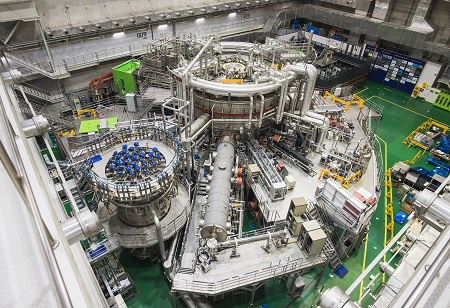
South Korea Breaks Nuclear Fusion Record: Plasma Heated to Sun's Core Temp

 South Korean scientists have reached a groundbreaking achievement in nuclear fusion technology, establishing a new world record by maintaining temperatures of 100 million degrees Celsius for an extended duration. This temperature, surpassing the core of the sun by sevenfold, was sustained throughout a nuclear fusion experiment, representing a substantial leap forward in the advancement of this futuristic energy source.
South Korean scientists have reached a groundbreaking achievement in nuclear fusion technology, establishing a new world record by maintaining temperatures of 100 million degrees Celsius for an extended duration. This temperature, surpassing the core of the sun by sevenfold, was sustained throughout a nuclear fusion experiment, representing a substantial leap forward in the advancement of this futuristic energy source.
Nuclear fusion, mirroring the mechanisms fueling the sun and other celestial bodies, entails merging two atoms to unleash immense energy. This environmentally friendly energy reservoir holds the potential to offer boundless energy without adding to carbon emissions, making it a crucial solution in addressing climate change. Nonetheless, the report highlighted the substantial technical hurdles in replicating this phenomenon on Earth.
The tokamak, a torus-shaped reactor, holds the crucial aspect of attaining fusion energy by heating hydrogen isotopes to generate plasma—a state of matter characterized by the separation of atomic nuclei and electrons. Si-Woo Yoon, the director of the KSTAR Research Center at the Korean Institute of Fusion Energy (KFE), emphasizes the importance of sustaining high temperatures and densities in plasmas, where fusion reactions can take place for extended periods, as pivotal for the success of forthcoming nuclear fusion reactors.
The KSTAR device, dubbed an 'artificial sun' by the KFE, achieved this latest record by sustaining plasma temperatures of 100 million degrees for 48 seconds during tests conducted between December 2023 and February 2024. This achievement surpasses the previous record of 30 seconds set in 2021. Adjustments made to the procedure, such as replacing carbon with tungsten in diverters components tasked with eliminating heat and impurities from the fusion reaction, played a key role in prolonging the plasma state.
The ultimate goal for KSTAR is to maintain these plasma temperatures for 300 seconds by 2026, a milestone that Si-Woo Yoon considers a "critical point" for scaling up fusion operations. The advancements made in South Korea are expected to contribute significantly to the development of the International Thermonuclear Experimental Reactor (ITER) in southern France, the world's largest tokamak, which aims to demonstrate the feasibility of fusion energy.
This declaration comes after a string of advancements in nuclear fusion exploration, including a triumphant reaction at the National Ignition Facility in the United States, where the energy produced surpassed the energy input, and a record-breaking fusion energy output achieved near Oxford, England.

